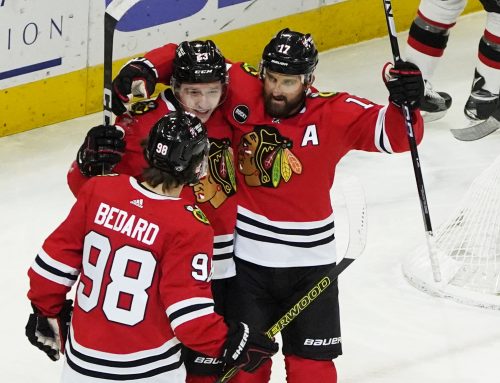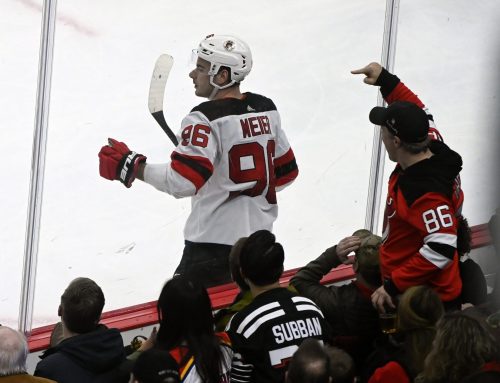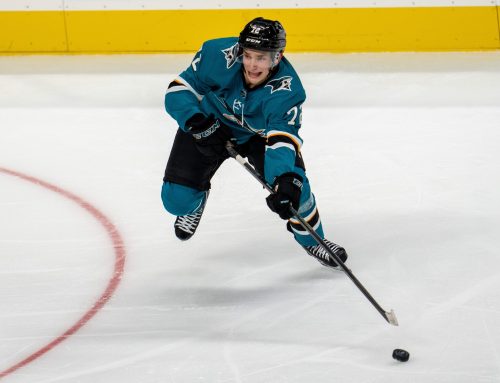Ramblings: Blues/Bruins Game 4; Prospects Report; Marchessault; Johansen – June 4
Michael Clifford
2019-06-04

St. Louis evened the Stanley Cup Final at two games each on Monday night with a 4-2 win over Boston. While this game didn’t feature the out-and-out nastiness and dirty play that we’ve seen at times, it didn’t lack for physicality, particularly in the second period.
The story was Ryan O’Reilly. It seemed like he found another gear all game long, rarely being out of place save for a short-handed goal against where he may have been over-aggressive. He scored the first and last goal of the night, the latter on a rebound from Alex Pietrangelo, who had a great game himself.
Once again, the teams traded tallies and gave us a 2-2 contest heading into the third period. Vladimir Tarasenko scored the second St. Louis goal, his 11th of the playoffs. For his career, Tarasenko has 33 goals in 67 playoff games. Seems like he’s a pretty underrated playoff performer.
Zdeno Chara was hit in the face with a deflected Jaden Schwartz shot and left the game early in the second frame. He did return for the start of the third period with a full cage but didn’t actually take the ice. He was there for support and nothing more. We'll provide an update if we get one.
[Editor’s note: it was a deflected shot from Brayden Schenn, not Schwartz]
St. Louis matched their fourth line against Bergeron’s line most of the night and did very well. They were all near or above a 50 percent shot share and kept the opposing trio off the score sheet in their minutes. (Bergeron and Marchand assisted on a short-handed goal).
*
Trade!
We got a trade during the first period of Game 4 as Philadelphia acquired the rights to unrestricted free agent centre Kevin Hayes from Winnipeg for a fifth-round pick in this year’s draft. The Flyers are now the only team that can sign Hayes until July 1st, assuming they don’t trade his rights again.
First, it should be noted that the Flyers have loads of cap space. Assuming an $83-million upper limit next year, they have about $33.4-million to use. They do have to sign Travis Konecny, Ivan Provorov, and Travis Sanheim, among others, but they would still have room to sign Hayes assuming a reasonable cap hit. For a reference on what cap leaguers can expect for Hayes, Brock Nelson signed for six years with a $6-million cap hit a couple weeks ago. I assume Hayes gets a bit more than that.
Second, as it was often pointed out on social media, is whether or not Kevin Hayes wants to play under Alain Vigneault. I’ll leave that for other people to decide.
*
There was a very interesting tweet from Taylor Hall over the weekend championing the entertainment value of the NBA:
Following the NBA more closely with this Raptors run has really opened my eyes to how great a league it is. There is a real sense of bravado and showmanship that you don’t see in other sports. The stars are on display every night and it’s impressive
— Taylor Hall (@hallsy09) May 31, 2019
The NBA does a fantastic job of not only promoting their stars but letting their players show their personality. Other sports – hockey included – could take notes from that.
It’s hard to take umbrage with Hall’s stance too, though I’m sure many will. Per Travis Yost of TSN, here is the NBA’s growth over the last ~20 years, with the focus on the last few seasons:

Meanwhile, from Sean Tierney (a well-known analytics aficionado), here is the NHL’s growth over the last decade and a half:

The NBA has seen their revenue double over the last seven-ish years while it took the NHL about twice that long to accomplish the same feat. That the NBA has several household names while other pro athletes think that Connor McDavid is Canada’s Prime Minister speaks volumes.
It’s hard to force people to be entertaining if it’s not their natural disposition but we should be celebrating those who are. Whether it be Carolina’s Storm Surge, over-the-top goal celebrations, taunts through interviews, or even just their promotion on social media, the NHL should be doing all it can to really drive home the personality of the players who show some.
*
It's finally available! The 2019 Dobber Hockey Fantasy Prospects Report is here! It has rankings, profiles, future production, and a whole lot more for fantasy owners in all types of leagues. Grab the edge you need over your league mates in the Dobber Shop now.
*
I was reviewing some power play data from the last few years and noticed something kind of odd about Jonathan Marchessault. Over the course of two seasons from 2015-17, which spanned about 313 minutes at five-on-four, Marchessault landed 12.6 shots per 60 minutes with a 16.7 percent shooting percentage. That led to him scoring 11 goals on 66 shots in those 313 minutes, or a rate of about 2.1 goals per 60 minutes. That rate, over those two years, was nearly in the top-30 league-wide, and just lower than names like T.J. Oshie and Cam Atkinson. Over his last two years in Vegas, Marchessault’s 5v4 shot rate has exploded to 18.4 per 60 minutes. On the flipside, however, his shooting percentage has declined to 8.3 percent. That means despite roughly 80 more minutes of 5v4 ice time, and nearly doubling his shot total from the previous two seasons, Marchessault scored fewer goals over his most recent two years (10) than the two years prior (11).
The thing is, Marchessault has been moved all over the power play over his four seasons in the NHL. From Hockey Viz, his shot location on the power play back in Tampa in 2015-16 was mostly from the bumper position in the middle of the ice.
This is his shot chart from 2016-17 in Florida:

When he got to Vegas in 2017-18, they used him almost exclusively from the left face off dot, and here is from 2018-19 with the Golden Knights:

It’s why I have a tough time grasping Marchessault’s goal scoring on the power play. This isn’t a guy who’s had a consistent role so it’s tough to compare. That especially rings true when considering he’s been on three teams in four years, having to learn how to play within different systems, how to play with different players, getting used to defensive structures you see most often, and so on.
There isn’t a whole lot to complain about. Marchessault has had 16 PPPs each of the last two years and considering Vegas is another team who splits their PP time almost equally, that’s not bad. We can’t really expect more than 20 or so. But I just wonder if Marchessault has more to give as far as production in the minutes is given is concerned. With his shooting percentage, I have to think yes, and any sort of percentage binge, combined with those high shot rates, could mean a lot of PP goals.
Key word: could.
*
A list of players with at least 1:30 of five-on-four PP ice time per game in 2018-19 who didn’t score a goal:
I’ve already covered Keller at length this off-season and discussed Svechnikov at length throughout the regular season. Nielsen and Panik deserve coverage but I’ll save that either for later this week or sometime next week.
Let’s talk about Ryan Johansen.
He’s being brought up specifically because it’s not just him. The team was bottom-5 in the league in goals scored per 60 minutes at 5v4, which is weird because they were a top-10 team in 2017-18. Johansen hasn’t been a big PP goal guy in a few years now but he did have four in 2016-17. He is capable of producing something.
Filip Forsberg also had a poor season at five-on-four, scoring just four goals in 63 games. For reference, he had 11 the year before in a similar number of contests. Even Viktor Arvidsson, with his 34 total goals in 58 games, saw a career-low goal rate at five-on-four.
This is all brought up because of the off-season the Predators have ahead of them. Their Stanley Cup window is still firmly open, with the core of their team all age-30 or younger, but there are changes coming. They may be minor, but it certainly looks as though it will involve bigger names like P.K. Subban and possibly Kyle Turris. More than anything, from a fantasy perspective, we need them to figure out the power play. Forsberg is capable of a point-per-game pace, Arvidsson can score 40 goals, and Johansen can reach 60 assists. Can they bring it all together in 2019-20?
*
While writing the above, a thought entered my brain: some sort of Kessel-for-Subban swap makes a lot of sense for both teams. They’d have to figure out any additional pieces needed to balance the trade, but it would help address Nashville’s scoring issues while bolstering Pittsburgh’s blue line. Both players have three years left on their current deals, which would largely coincide with both teams’ Cup windows; Malkin, Letang, Forsberg, and Ekholm all have three years remaining on their contracts. I think it makes some sense.
*
Just planting my flag on this one now: I will be drafting Kailer Yamamoto a lot come September.
*
Here’s a fun one (your level of fun may vary depending on how many leagues you owned him): Jamie Benn had one (1) five-on-four assist in 2018-19. He had the lowest assist rate of any forward with at least 150 minutes with the one-man advantage. For reference, Benn has never had fewer than five in any season of his career and had hit double-digits in five straight seasons before last year.
*
Just a little mini-rant to end things today.
We’re at the point in the fantasy hockey life cycle where more and more stats are being introduced, and that’s changing the landscape pretty much annually. Ten years ago, the vast majority of people didn’t know about shot attempts, and now we get heat maps on broadcasts. Five years ago, the tracking of zone entries/exits was being done publicly by literally one person, and now it seems all team blogs have someone doing this in some fashion (though that one person, Corey Sznajder, is still at it). Now, these stats, among many others, are being incorporated into season-long and daily fantasy projections to varying degrees by most of the fantasy hockey world.
The biggest question in fantasy sports, any fantasy sport of any sort, is this: where is the edge? Where do I (or, you, the reader) have an advantage over the people I’m (you’re) competing against?
I don’t want to say it’s the only question that matters but it’s vitally crucial to long-term success. The joy (and appeal) of most fantasy sports is that anyone can win a season-long league in any given year or a DFS tournament on any given day. Winning consistently, however, year after year, or day after day, is another matter entirely.
It’s a question of expectations, too. Let’s say you have a 12-team home league that’s been running for 10 years. Winning the league twice in those 10 years is a great feat! But you can go four years without finishing in the top-3 and feel like you’re doing something wrong. We should expect to win any league we join, but the reality is that even winning one in six leagues we join is a huge accomplishment.
Back to the original point of finding the edge. With many people using more or less the same projections based on more or less the same stats, how we use that information is what differentiates consistent winners from the rest of the pack. I’m going to talk more about finding an edge throughout the summer, but it’s something to keep in mind when August and September roll around and we start joining leagues.





 WSH
WSH NYR
NYR NSH
NSH VAN
VAN COL
COL WPG
WPG L.A
L.A EDM
EDM CHI
CHI T.B
T.B CAR
CAR NYI
NYI N.J
N.J
